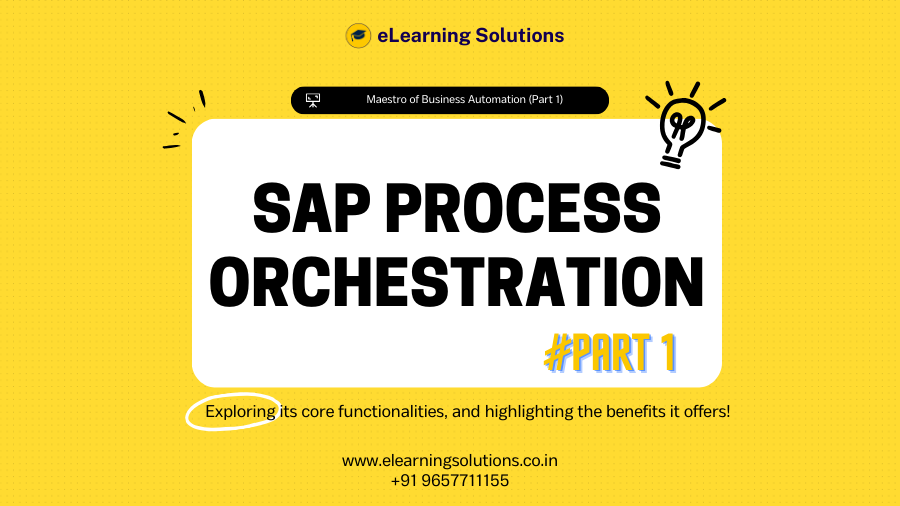In today’s interconnected business landscape, seamless communication and process flow are no longer luxuries – they’re necessities. This is where SAP Process Orchestration (PO) steps onto the stage, acting as the conductor of your organization’s symphony of applications and data.
But what exactly is SAP PO, and how can it empower your business? In this first part of our comprehensive blog series, we’ll delve into the world of SAP PO, untangling its origins, exploring its core functionalities, and highlighting the benefits it offers.
An Introduction to SAP Process Orchestration
SAP PO is a powerful software solution designed to integrate disparate applications, automate complex business processes, and streamline data exchange within your SAP ecosystem. Imagine a scenario where your sales team needs to trigger an automatic credit check and inventory update in separate systems after receiving a customer order. Traditionally, this might involve cumbersome manual processes and error-prone data manipulation. Enter SAP PO – the maestro that orchestrates these tasks flawlessly, ensuring a smooth and efficient flow of information across your business landscape.
A Legacy of Integration: The Evolution of SAP Process Orchestration
The story of SAP PO is intrinsically linked to its predecessor, SAP Process Integration (PI). SAP PI, originally known as XI (Exchange Infrastructure), laid the foundation for seamless data exchange between SAP and non-SAP applications. However, SAP PO took the integration game a step further. Think of SAP PI as the reliable postman, delivering data packets efficiently. SAP PO, on the other hand, is the sophisticated logistics manager, not only ensuring timely delivery but also coordinating the flow of information, automating tasks, and overseeing the entire business process.
Core Functionalities: The Power of SAP PO
SAP PO boasts a robust set of features that empower you to achieve true business process automation. Here are some of its core functionalities:
- Integration: Connect your SAP system with various internal and external applications, enabling seamless data exchange regardless of their underlying technologies.
- Process Automation: Define and automate complex business processes, eliminating manual tasks and streamlining workflows across your organization.
- Data Transformation: Cleanse, transform, and map data between different systems to ensure consistent and accurate information flow.
- Business Activity Monitoring (BAM): Gain real-time insights into your business processes, identify bottlenecks, and optimize performance.
- Security: Enforce robust security measures to protect sensitive data throughout the integration process.
The Symphony’s Advantage: Unveiling the Benefits of SAP PO
By leveraging SAP PO, your organization can reap a multitude of benefits:
- Improved Efficiency: Automate manual tasks and streamline processes, freeing up valuable time and resources for your team.
- Enhanced Accuracy: Eliminate human error associated with manual data entry and manipulation, leading to more accurate data across your systems.
- Increased Agility: Respond quickly to changing business needs by adapting and automating processes with greater ease.
- Reduced Costs: Minimize the resources required for manual data integration and process execution, leading to cost savings.
- Improved Decision Making: Gain real-time insights from your integrated systems, enabling data-driven decision making.
Beyond the Stage: Comparing SAP PO with Other Integration Options
While SAP PO is a powerful tool, it’s important to understand its place within the broader SAP integration landscape. Here’s a brief comparison with another popular option:
- Cloud Integration Platform (SAP Cloud Integration): A cloud-based solution offering a user-friendly interface and pre-built integration content for faster time to value. Ideal for businesses seeking a scalable and flexible integration solution.
The choice between SAP PO and Cloud Integration Platform depends on your specific needs and infrastructure. SAP PO offers a more robust on-premise solution for complex integrations, while Cloud Integration Platform provides a faster and more user-friendly cloud-based option.
Conclusion: Part 1 – A Foundation Laid
In this first part of our blog series on SAP Process Orchestration, we’ve established a strong foundation. We’ve explored the evolution of SAP PO from its roots in SAP PI, delved into its core functionalities, and unveiled the numerous benefits it offers for business process automation and integration.
In the next part of this series, we’ll delve deeper into the technical aspects of SAP PO, exploring its architecture, key components, and the process of building and deploying powerful business process automation solutions. Stay tuned to become a maestro of your own SAP ecosystem with the power of Process Orchestration!



 WhatsApp us
WhatsApp us